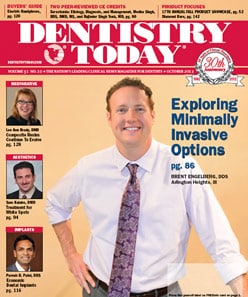Primary and Adult Teeth
 The mouth contains 20 primary or “baby teeth” that are lost at various ages throughout childhood, and 32 permanent or “adult teeth,” which are intended to remain in the mouth throughout life. Most babies begin experiencing the eruption of their first primary teeth before the age of 7 months, however there is a substantial range of months from child to child. Typically it is the front two incisors on the lower arch that erupt first, however in many instances, it will be the upper two central incisors—either way parents need not worry as in time all of the teeth will typically erupt with little issue. Teeth numbering systems in the United States use different techniques, however the Universal Numbering Systems start with the posterior (back) right and wind around the upper arch and start again in the lower left posterior area and wind around to the lower right. Baby teeth are usually lettered as opposed to numbered in the United States from “A” to “T.” Tooth A is the upper right molar, and tooth J is the upper left molar. Tooth K is the lower left molar, and tooth T is the lower right back molar. Unless an adult tooth is missing, the primary teeth should all be lost around the age of 12-13, as the adult teeth begin coming in at the age of 6 with the “6-year molars,” and gradually force out the primary teeth. Wisdom teeth often do not have room to erupt in until years later, if at all due to space restrictions, therefore they are commonly removed. Adult teeth are numbered from 1-32, with tooth 1 being the upper right wisdom tooth, and tooth 32 being the lower right wisdom tooth in the Universal Tooth Numbering System.
The mouth contains 20 primary or “baby teeth” that are lost at various ages throughout childhood, and 32 permanent or “adult teeth,” which are intended to remain in the mouth throughout life. Most babies begin experiencing the eruption of their first primary teeth before the age of 7 months, however there is a substantial range of months from child to child. Typically it is the front two incisors on the lower arch that erupt first, however in many instances, it will be the upper two central incisors—either way parents need not worry as in time all of the teeth will typically erupt with little issue. Teeth numbering systems in the United States use different techniques, however the Universal Numbering Systems start with the posterior (back) right and wind around the upper arch and start again in the lower left posterior area and wind around to the lower right. Baby teeth are usually lettered as opposed to numbered in the United States from “A” to “T.” Tooth A is the upper right molar, and tooth J is the upper left molar. Tooth K is the lower left molar, and tooth T is the lower right back molar. Unless an adult tooth is missing, the primary teeth should all be lost around the age of 12-13, as the adult teeth begin coming in at the age of 6 with the “6-year molars,” and gradually force out the primary teeth. Wisdom teeth often do not have room to erupt in until years later, if at all due to space restrictions, therefore they are commonly removed. Adult teeth are numbered from 1-32, with tooth 1 being the upper right wisdom tooth, and tooth 32 being the lower right wisdom tooth in the Universal Tooth Numbering System.
Tooth Composition and Tooth Color
Natural teeth are comprised of four tissue types: enamel, dentin, cementum, and dental pulp. Cementum is the thin outer layer of a tooth root, and the pulp is the nerve and blood supply to the tooth. The dentin and enamel layers of a tooth are the two most commonly involved layers that need dental treatment, and are absolutely the most important two layers for esthetic dentistry. For the purposes of this discussion, we will focus on enamel and dentin within the context of cosmetic dentistry and composite resin.
The normal color of enamel ranges from a white and yellow color to a grey hue of white. At the biting edges of teeth there is nearly 100% enamel, and no underlying dentin (which is more yellow), therefore the color can take on a blue tone. Enamel is semitranslucent, therefore the color of the underlying dentin is very important in determining the shade of the tooth. When selecting a composite resin, the highest level of esthetics can be achieved through the use of different shades and translucencies of composite resins layered in a manner that mimics what is found in a natural tooth. It is vital that a cosmetic dentist understand the makeup of a natural tooth, and then follow this makeup throughout the restorative process.
Dentin is found between enamel and the pulp. Is it porous and yellow in color, however as patients age, the dentin can become a darker yellow or even brown. Some patients who have taken certain antibiotics when the dentin was forming can have an impossible to remove grey color in their dentin. This presents a substantial challenge for a cosmetic dentist to mask with composite resin or even veneers. Dentin is mineralized connective tissue with a protein (collagen) matrix, but there are channels, called dentin tubules, that can be used to bond composite resin to. Dentin has 10% water by weight, and this inhibits bonding, however if the tubules were to “collapse” in the absence of water, then the dentin bonding agents cannot perfectly infuse with the tooth structure.
Dental bonding is performed by cosmetic dentists to restore broken, chipped, mishapen, partially decayed or discolored teeth. With dental bonding, a composite material that resembles your natural tooth color is sculpted into place, then shaped and hardened using UV light or laser.












